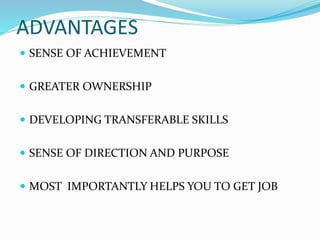Career planning
- 2. MEANING The process of establishing career objectives and determining appropriate educational and developmental programs to further develop the skills required to achieve short- or long- term career objectives.
- 3. CAREER PLANNING IN AN ORGANISATION •Career planning is the process by which one selects career goals and the path to these goals. The major focus of career planning is on assisting the employees achieve a better match between personal goals and the opportunities that are realistically available in the organization. •Career planning is not an event or end in itself, but a continuous process of developing human resources for achieving optimum results. •A person who is not able to translate his career plan into action within the organization may probably quit the job, if he has a choice. • Organizations, therefore, should help employees in career planning so that both can satisfy each other’s needs.
- 4. CAREER PLANNING PROCESS IDENTIFYING INDIVIDUAL NEEDS AND ASPIRATIONS ANALYSING CAREER OPPORTUNITIES ALLIGNING NEEDS AND OPPORTUNITIES ACTION PLANS AND PERIODIC REVIEW
- 5. IDENTIFYING INDIVIDUAL NEEDS AND ASPIRATIONS Most individuals do not have a clear cut idea about their career aspirations, anchors and goals. The human resource professionals must, therefore, help an employee by providing as much information as possible showing what kind of work would suit the employee most, taking his skills, experience, and aptitude into account. Such assistance is extended through workshops/seminars while the employees are subjected to psychological testing, simulation exercises, etc. The basic purpose of such an exercise is to help an employee form a clear view about what he should do to build his career within the company.
- 6. ANALYSING CAREER OPPORTUNITIES Once career needs and aspirations of employees are known, the organization has to provide career paths for each position. Career paths show career progression possibilities clearly. They indicate the various positions that one could hold over a period of time, if one is able to perform well. Career paths change over time, of course, in tune with employee’s needs and organizational requirements.
- 7. ALLIGNING NEEDS AND OPPORTUNITIES This process consists of two steps: first, identify the potential of employees and then undertake career development Through performance appraisal, the potential of employees can be assessed to some extent. Such an appraisal would help reveal employees who need further training, employees who can take up added responsibilities, etc.
- 8. ACTION PLANS AND PERIODIC REVIEW After initiating these steps, it is necessary to review the whole thing every now and then. This will help the employee know in which direction he is moving, what changes are likely to take place, what kind of skills are needed to face new and emerging organizational challenges. From an organizational standpoint also, it is necessary to find out how employees are doing, what are their goals and aspirations, whether the career paths are in tune with individual needs and serve the overall corporate objectives, etc
- 9. DISADVANTAGES UNCERTAINITY MULTIPLE SOLUTIONS BENEFICIAL ACTIVITIES FLEXIBILITY
- 10. ADVANTAGES SENSE OF ACHIEVEMENT GREATER OWNERSHIP DEVELOPING TRANSFERABLE SKILLS SENSE OF DIRECTION AND PURPOSE MOST IMPORTANTLY HELPS YOU TO GET JOB











